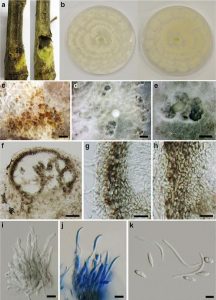Diaporthe tectonigena Doilom, A.J. Dissanayake & K.D. Hyde, sp. nov., Index Fungorum number: IF551977
Etymology: Name refers to the host genus Tectona on which the fungus was collected, −gena are used for a second species from the same host.
Holotype: MFLU 15–3534
Associated with twig dieback on T. grandis. Sexual morph: Undetermined. Asexual morph: Colonies on PDA, Conidiomata pycnidi a l , (170–)270–310(−360) μm× (165–)280–295(−320) μm (x = 265× 268μm, n = 25), scattered or aggregated, black, erumpent at maturity, subglobose or variable in shape, with an elongated black neck, with conidial mass; initially hyaline to yellowish, reddish brown to umber, becoming white to cream conidial droplets exuding from central ostioles after 20 days in light at 25 °C, multilocus; pycnidial wall composed of a textura angularis, comprising of two cell layers, outer layer; black to dark brown, thick-walled, inner layer; hyaline, thin-walled. Conidiophores 9–32× 1.8–3.7μm, hyaline, branched to unbranched, cylindrical, septate, smooth, occurring in dense clusters, straight or slightly curved, rounded to obtuse at the apex, wider at base. Conidiogenous cells 2–5 × 1.3–3.9 μm, phialidic, cylindrical, terminal, with slight tapering towards apex. Alpha conidia (5–)7.3–7.8(−8.3) μm×2.5–3.5μm (x = 7.2× 2.9μm, n = 30), multiguttulate, hyaline, oblong to ellipsoid, apex bluntly rounded, base obtuse to subtruncate, smooth. Beta conidia (16–)29–30(−34) μm×1.4–2μm (x = 28 × 1.7 μm, n = 30), filiform, hyaline, curved or hamate, aseptate, base subtruncate. Gamma conidia (9–)10–12(−14) μm×1.7–3.2μm (x = 11× 2.3μm, n = 30), aseptate, hyaline, multiguttulate, smooth, ellipsoid–fusoid, apex acutely rounded, base subtruncate.
Culture characteristics: Pure culture was isolated by subbing hyphal tips growing from surface sterilized diseased material. Colonies on PDA reaching 63–71 mm diam. after 4 days in the dark at 25 °C, (x = 67.2, n=5), lobate, with concentric rings of dense and sparse hyphae, irregular margin, after 10 days white (4A1) from above, from below yellowish white (4A2), reaching the edge of the Petri-dish after 6–10 days.
Habitat: Associated with twig dieback of T. grandis (Doilom et al. 2017).
Known distribution: Thailand (Doilom et al. 2017).
Material examined: THAILAND, Chiang Rai Province, Muang District, on dieback lesions of T. grandis twigs, 19 November 2012, M. Doilom, (MFLU 15–3534, holotype (dry-culture)), ex-type living culture MFLUCC 12–0767, MKT 085/3, ICMP 21169, GenBank Accession No: CAL: KU749358, ITS: KU712429, TEF1: KU749371, TUB: KU743976.
Notes: Although, Udayanga et al. (2012) did not provide a species name and details for Diaporthe sp. (MFLUCC 10– 0587), it was included in the phylogenetic analysis as that isolate was also collected from T. grandis. The multi-gene phylogenetic analysis however distinguished D. tectonigena from Diaporthe sp. MFLUCC 10–0587.
FIG: Diaporthe tectonigena (MFLU 15–3534, holotype). a Dieback lesions. b Colony on PDA after 10 days (above and below views). c–e Conidiomata with conidia mass sporulating on PDA after 1 month. f Section through conidiomata. g Peridium. h Outer conidiomatal wall. i, j Conidiogenous cells. k Conidia. Notes: g, h Stained in lactophenol cotton blue. Scale bars: c, d = 1000 μm, e = 500μm, f–h = 50 μm, i = 10μm, j, k = 5μm

